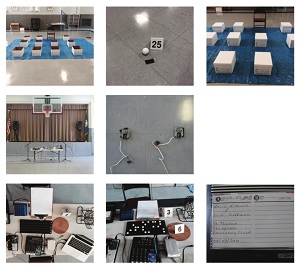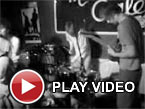Devin DiSanto/Nick Hoffman, "Three Exercises"
 Fun is too often ignored when talking about experimental music. The language surrounding works by composers like Iannis Xenakis or Luc Ferrari is usually technical or mathematical, and sometimes political, but it’s rarely euphoric or exuberant. Which is a shame, because the flash of their audaciousness and the buzz of excitement their music generates is just as dignified and as worthy as the theory running beside it. Devin DiSanto and Nick Hoffman’s Three Exercises, which takes some inspiration from both Xenakis and Ferrari, is a lot of things. There should be no shame or reticence in recognizing that chief among them is fun. Recorded at St. Thomas the Apostle Elementary School in West Hartford, Connecticut, it spins amusement and pleasure from sources both unusual and mundane, with humdrum objects like ping pong balls and duct tape, and with homemade instruments like the one Hoffman tests in this video, which utilizes dynamic stochastic processes. Tucked away behind these sounds are ideas about the relationships between artists and audiences, structures and performances, and between spaces and sounds. Theory and technicality still figure into the mix, only they are inseparably attached to the noises that DiSanto and Hoffman deploy, and are as much a part of the fun as the chaos of the music.
Fun is too often ignored when talking about experimental music. The language surrounding works by composers like Iannis Xenakis or Luc Ferrari is usually technical or mathematical, and sometimes political, but it’s rarely euphoric or exuberant. Which is a shame, because the flash of their audaciousness and the buzz of excitement their music generates is just as dignified and as worthy as the theory running beside it. Devin DiSanto and Nick Hoffman’s Three Exercises, which takes some inspiration from both Xenakis and Ferrari, is a lot of things. There should be no shame or reticence in recognizing that chief among them is fun. Recorded at St. Thomas the Apostle Elementary School in West Hartford, Connecticut, it spins amusement and pleasure from sources both unusual and mundane, with humdrum objects like ping pong balls and duct tape, and with homemade instruments like the one Hoffman tests in this video, which utilizes dynamic stochastic processes. Tucked away behind these sounds are ideas about the relationships between artists and audiences, structures and performances, and between spaces and sounds. Theory and technicality still figure into the mix, only they are inseparably attached to the noises that DiSanto and Hoffman deploy, and are as much a part of the fun as the chaos of the music.
"Preparation/Introduction," the first song on Three Exercises, drops its audience into St. Thomas in media res. Devin and Nick have already arrived and are nearly finished arranging all of the instruments and paraphernalia featured on the cover of their album. Sounds from outside the building leak into the room, doors open and close, a car horn honks, and various devices are tested before a brief series of conversations ensue. "So yeah, it’s pretty straightforward," someone says. Then, "Did you have to walk around the building at all?" There’s an audience apparently, and instructions, and a whole lot of shuffling of paper and plastic.
Devin then announces the date, introduces both himself and Nick, and "Sequence 1" begins. A voice says, "Devin introduces Nick... and himself," and before the repetition can register, a blast of bass-heavy noise flies from the speakers. It stops suddenly and is followed by the sound of glass pebbles, echoing footsteps, and more voices, apparently describing the actions responsible for some of the sounds. The effect is dizzying. DiSanto and Hoffman perform, their audience describes, and the music is tied into a knot of observations, noises, objects, and actions. There’s a sense that every possible thing Devin and Nick could have included on the album is included: all the tools, the composition (if there is one, and if not, the instructions), the thoughts of the people hearing the music for the first time, the hum of amplifiers, the echo of the gymnasium itself. Even the preparations and notes for recording the album are a part of the album, in a direct, fourth-wall-breaking kind of way.
But there’s a lot of deliberation too. Sounds are cut and layered cinematically, as if to give the listener a chance to see the same thing from two different perspectives. When Justin Palmer and Sharon Glassburn, the two observers who narrate the proceedings, speak, they cycle through a variety of tones: bemused, quiet, like someone on a birdwatching expedition, tense, theatrical. In each case there’s a voyeuristic rush inherent in their speech. There's a secret or a ritual unfolding on this album and these participants are relaying it to the outside covertly. The album’s visual qualities grow out of these segments as well. Had each "Sequence" or "Exercise"  been thoroughly logged, Three Exercises might have become something like a documentary, but DiSanto and Hoffman stop just short of that, teasing the audience with tidbits rather than exhaustive descriptions. The parts are all relatively clear, how and why they fit together is left obscured.
There’s also a sensitivity toward the density of different passages and an appreciation for the sonic similarities among diverse groups of things, like basketballs, shoes, service bells, and synthesizer tones. The space they are in, it’s shape and size, solidifies as moments of high intensity and near silence pass, so that the way the music is arranged, the way the instruments are set up, and the distances between events and objects, all register clearly. To have so much happening on an album, and at the same time to have it all so thoughtfully laid out and superbly produced, is overwhelming in the best possible way. Three Exercises is a complex and stratified album, with a ton of depth and thoughtfulness built into it. Listening naturally elicits questions and insights, about how hearing or seeing a performance changes our reaction to it, or about how audiences help to complete a piece of music just by thinking about it. But it's a boisterous and playful enough record to thrill with its audible dimensions alone.
samples:
 



